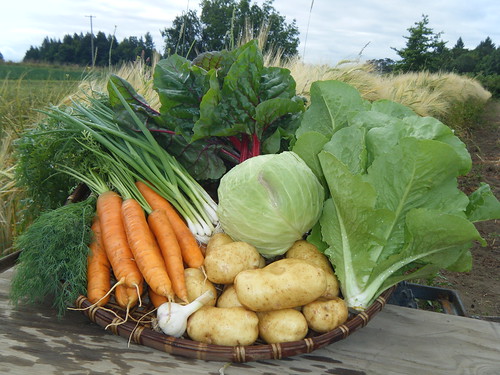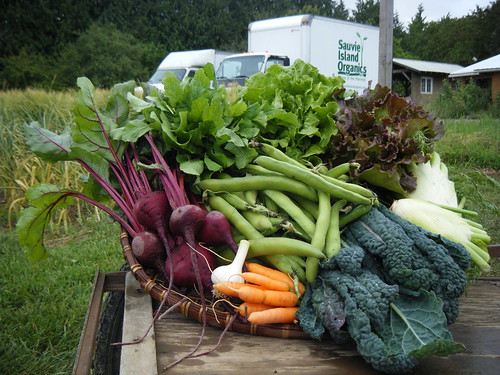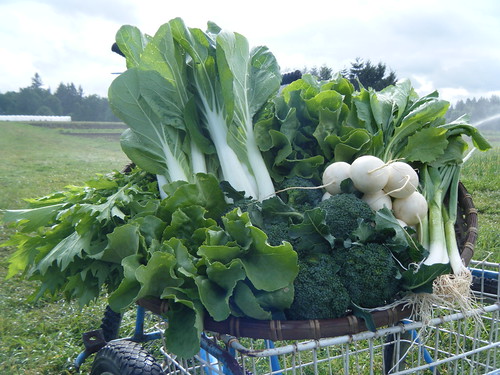This Week’s Share
Share Notes
- Carrots: This week in your share you will receive three pounds of beautiful carrots. We are at the point in the season where the cool weather and heavy rains of the late spring and early summer have slowed the summer squash and beans down by a week or so…they are looking great in the field and will be on on the way in abundance soon.
Recipes
Carrot Recipes
Pickled Carrot Spears with Dill
Recipe adapted from EdiblePortland, by Lucy Norris
Note: This recipe can is easily doubled to make 4 pints.
1 lb large carrots (peeled and cut into spears), or whole small carrots
2 garlic cloves (peeled)
2 whole small chili peppers
2 sprigs dill
1 tsp celery seed (1/2 tsp per jar)
1 1/4 cups white distilled vinegar
1 1/4 cups water
1/8 cup coarse salt (Kosher or pickling)
2 clean pint jars, with lids and lid rings
1. Into each clean pint jar, place one clove of garlic, one chili, one sprig of dill, and 1/2 teaspoon celery seed. Then pack carrots vertically into jars (be careful not to handle mouth of jar).
2. Meanwhile, combine vinegar, water, and salt in a saucepan and bring to a boil. Pour hot liquid over vegetables, leaving at least a 1/4-inch head-space. Remove air bubbles.
3. Place lid over mouth of jar, screw on cap, and then process jars in a hot water bath for 10 minutes (longer for elevations over 1,000 ft).
4. Allow jars to cool, and store in a dark cupboard for at least three weeks before tasting. Once opened, store in refrigerator for up to six months (only using clean utensils when handling).
Makes 2 pints
Romaine Lettuce Recipe
Caesar Salad
From Shannon Raider, a former SIO Farmer
Note: If you like a little less intensity you can adjust the taste, just put in less garlic and anchovy.
1-2 head(s) romaine lettuce, washed and torn into salad-size pieces
3 cloves garlic
2 tablespoons olive oil, plus ¾ cup olive oil
½ tin of whole anchovy fillets
1 tablespoon dry mustard
2-6 shakes of Tabasco sauce
2 tablespoons Worcester sauce
1 raw egg yolk or 1 coddled egg yolk*
¼ cup lime juice
¼-½ cup grated parmesan cheese
salt and fresh ground black pepper, to taste
In the bottom of the bowl that you will serve your salad into, work 3 cloves of garlic into a paste with 2 tablespoons olive oil and pinch of salt using two forks. Next, add half a tin (or one of those tiny jars) of whole anchovy fillets into the garlic paste in the same fashion. Adjust anchovy amount to your liking. Then add 1 tablespoon dry mustard, 2-6 shakes of Tabasco sauce and 2 tablespoons Worcester sauce. Whisk in the raw egg yolk or coddled egg yolk*. Whisk in 3/4 cup olive oil and 1/4 cup lime juice. Stir in grated Parmesan Cheese (at least a 1/4 cup, but I like a lot of cheese). Add salt and generous amounts of ground black pepper to taste. Pour dressing into a jar and toss salad in the well seasoned bowl, toss with as much dressing as you like. Extra dressing can be stored for up to one week in the refrigerator.
*Coddling causes the egg white to cook and leaves the yolk liquid. This sterilizes the egg of any bacteria that could contaminate. Bring egg to room temperature. Place the egg in a small bowl or mug and pour boiling water around the egg until it is covered. Let stand for exactly 1 minute. Immediately run cold water into the bowl.
Potato Recipe
Herbed Potato Salad
From Francesca Benedetti, CSA Coordinator at SIO
1 1/2 pounds new potatoes
2 tablespoon chicken or vegetable broth
1 tablespoon white wine vinegar
Juice of ½ a lemon
1/2 teaspoon Dijon mustard
3 tablespoons olive oil
1-2 cloves garlic, minced
4 scallions, finely chopped
2 tablespoons dill, finely chopped
Salt and pepper, to taste
No need to peel these beautiful new potatoes, just wash and cut them into bite-size pieces. Boil them in lightly salted water until fork tender, this should take 8 to 10 minutes max. Keep an eye on them, you don’t want to over-cook them. When tender, remove potatoes from heat, drain, and set aside.
In a large bowl combine oil with white wine vinegar. Squeeze in the lemon juice, pour in the chicken broth (vegetable broth for the vegetarians among you), Dijon mustard and whisk away. The vinaigrette will become thicker. Add garlic and dill to the large bowl and season with salt and pepper. Whisk dressing until very well combined. Add potatoes to the dressing while they’re still warm, that way they’ll take on the flavors even more. Sprinkle the chopped spring onions in there and let the potato salad cool off. Serve the potato salad at room-temperature or cold.
Chef’s Corner: July
In addition to the crops SIO grows for our CSA program, we also grown and sell produce to 30-40 Portland area restaurants and kitchens, and this season at SIO we are partnering with some of those restaurants for some culinary inspiration. We have been picking the brains of some of the areas most talented chefs and restaurant owners, and have asked them to provide us with recipes and general cooking techniques based on the crops that you receive in your shares. Out at the farm we crop plan separately for both our CSA program and restaurant sales, so you don’t have to worry that part of your share may be going the restaurant down the street. For the month of July our featured restaurant is clarklewis, located in the close-in Southeast Industrial neighborhood along the Willamette River.
Dolan Lane, Chef at clarklewis
Since 2003 clarklewis has been the standard-bearer for the farm-to-table food movement in Portland. The philosophy has been rigorously maintained by Bruce Carey and Chef Dolan Lane since they took over the operation in 2007. We create delicious hand-crafted Northwest cuisine with Italian and French influences, and proudly support our local farmers.
Each year I look forward not only to what each changing season brings but building new relationships with farmers, cheese makers, ranchers and all who contribute to making Oregon the great food region it has become. This has been my first year using SIO’s produce, and to be honest they have yet to disappoint. From the flavorful and bright greens to the tender broccoli, I look forward to see what they bring this growing season and many to come.
Recipes
Roasted Beet Salad with an Oregon Blue Cheese Terrine, Arugula and Red Port Vinaigrette
Serves 4
For the beets:
3-4 med sized red beets
1 Tbl olive oil
Salt and pepper
Pre-heat oven to 375. Wash beets and toss in a bowl with the olive oil and season.
Place in a roasting pan lined with foil and cover with foil. Roast for 45 minutes to an hour or until wood skewer slides thru the beats easily. Let cool to touch and peel off skin. Cut each beet into 6-8 wedges and reserve.
For the terrine:
6 ounces Rogue River Oregon blue cheese (room temp)
3 ounces softened butter
1 tablespoon brandy
10 sprigs thyme picked and rough chopped
½ cup hazelnuts roasted, peeled and rough chopped (reserve half for finish)
Salt and pepper
In a mixing bowl combine all ingredients and season to taste. Line small container with plastic wrap with excess hanging over sides. Place cheese mixture inside and fold extra plastic over to shape small rectangle. Place in fridge and set up for at least 6 hours.
For the Port Vinaigrette:
¼ cup red wine vinegar
¾ cup olive oil
½ cup red port
1 tablespoon balsamic
1 shallot minced
1 tablespoon fresh thyme
Salt and pepper
Sauté shallot until opaque, add port and balsamic and reduce by ¾. Remove from heat and cool to room temp and whisk in remaining ingredients.
To serve:
Lightly dress roasted beets with port vinaigrette and dived onto 4 plates. Add arugula to bowl and coat with remaining vinaigrette that is left in bowl also coating lightly. Season and place on top of beets. Slice 4 pieces of terrine about 2 oz each and place on arugula.
Grilled bread can be served with or toasted walnuts.
Poached New Potatoes with Astoria Boquerones
This is simple but a great hors d’ouevre for the summer.
Astoria boquerones are a new local producer of these Spanish delights.
12 new potatoes
12 Astoria boquerones
Olive oil, for drizzling
Fleur de sel, to taste
Place 12 each new potatoes in cold salted water. Put on med heat and cook until almost tender and turn off heat a let slowly finish cooking in the warm water. Once potatoes are completely cooked remove from water and let cool.
Cut potatoes in half. Divide 12 boquerones in half length wise and place on potato, drizzle with olive oil and sprinkle with fleur de sel. Serve and enjoy.
Chilled Carrot Soup with Cilantro
Yield 2 Quarts
1 ½ pounds carrots, sliced
2 tablespoons cilantro chiffonade
1 onion, sliced
2 ribs celery, sliced
1 teaspoons toasted coriander ground
4 tablespoons crème fraiche (may substitute sour cream)
2 quarts vegetables stock
Salt and pepper
Sweat onions in olive oil until translucent; add celery, carrots, coriander
and continue to sweat for 5 minutes. Add vegetable broth, bring to simmer, and cook until vegetable are tender. Puree until smooth in blender. If necessary thin soup with more vegetable broth and season to taste. Chill soup. Serve in cold bowls with a dollop of crème fraiche and chiffonade cilantro.













